A dedicated spacecraft just to investigate the Alpha Centauri system? I’ve been fascinated with the nearest stars since boyhood, so the ACEsat concept Ashley Baldwin writes about today would have my endorsement. But budgetary realities and practical mission planning might demand a larger instrument capable of studying more distant targets. Dr. Baldwin, a committed amateur astronomer, is consultant psychiatrist at the 5 Boroughs Partnership NHS Trust (Warrington, UK). His deep knowledge of telescope technologies has served us well in the past, and now takes us into the realm of mission planning beyond the James Webb Space Telescope.
by Ashley Baldwin

ACEsat is a revolutionary all silicon carbide, 45 cm telescope concept with a bespoke built in Phase Induced Amplitude Apodisation (PIAA) coronagraph designed to image planets (in five selected visible-wavelength bands from 400-700 nm) in the habitable zones of Alpha Centauri A and B. It was designed to take advantage of studies that show a 10-55% probability of a 0.5-2R Earth planet in these areas. Other objectives included determining exoplanet size, mass and orbit as well as imaging any “debris disk”.
The mission was conceived by a team from NASA Ames led by Ruslan Belikov and Eduardo Bendek, in conjunction with Northrop Grumman, and was recently unsuccessfully submitted for NASA Small Explorer funding (SMEX). Only circa $100 million for a lot of telescope, the design when compared with the ongoing WFIRST (Wide-Field Infrared Survey Telescope) mission highlights the critical issues of directly imaging exoplanets with coronagraph-based telescopes. These are small at present, but the science is central to the potentially large telescopes of the 2030s. As the 2020 Decadal NASA “roadmap” for the next decade approaches, the battle lines are being joined for what comes after JWST. Yes, that far ahead!
Fitting Alpha Centauri into the Roadmap

At present the various astrophysics subcommittees have got together with universities to make recommendations to the NASA Executive for consideration. In terms of telescopes, the main examples are a 10-12m UV, Visible and Near-Infrared “all rounder” telescope that is likely to be segmented like a big JWST and be fitted with high performance coronagraphs for exoplanet imaging (see below ). There is also a large, segmented Far-Infrared telescope like a direct descendent of JWST, an X-Ray telescope and a 4m “Habex” dedicated exoplanet telescope.
Image: Centauri A and B as captured by Cassini over the limb of Saturn. Credit: NASA/JPL.
Science definition groups are in the process of being formed to try and reach a consensus on what will be prioritised in the Decadal roadmap. All of these missions would be classed as “flagship” (multi-billion $), and if WFIRST does fly, as appears likely, the money for the 2020s will be spent before they arrive! This plan is thinking 15 years ahead. There is no guarantee that an exoplanet telescope will be selected, though interest in the field is burgeoning, with one third of papers submitted to journals last year on the topic. The presence of both a Far-Infrared telescope and an X-Ray telescope illustrates the influence some groups historically maintain. The two imaging missions are intertwined and illustrate the process of imaging exoplanets with internal occulters or “coronagraphs”.
The PIAA coronagraph, as usual, stands out in all domains barring average contrast reached. This device has a substantial heritage over the last decade in small exoplanet imaging concepts such as EXCEDE (Exoplanetary Circumstellar Environments and Disk Explorer), PECO (Pupil mapping Exoplanet Coronagraphic Observer) and most recently the Probe concept Exo-C, a smaller version of which ACEsat is based on. Simulations show how important “post processing” of the raw data received from the telescope is.
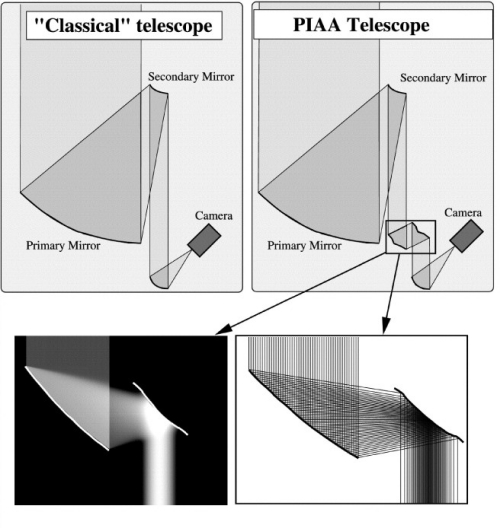
Image: An off axis telescope without and as ACEsat with a PIAA coronagraph. Credit: Wikimedia Commons.
Conventional methods will improve contrast by up to thirty times. This includes techniques that remove “speckles” or stray starlight within the telescope due to wavefront errors or mirror imperfections. “Angular differential imaging” removes these by rotating the image and subtracting it from the original non-rotated version. “Spectral differential imaging” takes advantage of subtle variations in the spectrum of reflected planet light. This will include the spectra of molecules in any atmosphere, which will be very different from back or foreground targets as well as exo-zodiacal light. Finally, when reflected off a planet, starlight tends to become more polarised, which differentiates it from the original starlight and background sources. Thus a polarimeter can separate out an exoplanetary signal. Ground-based telescopes used for exoplanet imaging, like the VLT, employ just such devices to run as part of an instrument package like SPHERE (Spectro-Polarimetric High-contrast Exoplanet REsearch) that also includes a coronagraph.
All of these methods are conventional and effective and, importantly, applied to the image after it has been taken or during the process of forming it. They are easy to do and don’t require multiple images. Compare this to the newest form of differential imaging, discussed below. These are ways of making the exoplanet stand out from the overall telescope field. That’s enough to take the telescope’s observations from “no image ” to “image”. The PIAA best contrast goes from just under 3×109 to 9×1011. In this case, that translates from seeing a large gas giant to seeing something Earth-sized. The post processing also takes some of the pressure of delivering contrast away from the coronagraph and its designers, too.

Image: Two habitable zones to work with in this close binary. What will we find around Centauri A and B?
How ACEsat Operates
ACEsat is a small, 45cm telescope, yet it can deliver contrasts down to 3×1011. How? Until recently there have been just two post processing techniques. The ACEsat team have cleverly created an additional technique called “Orbital differentiating imaging” (ODI). This uses an exoplanet’s orbit to identify it from the background “noise”. It is so potent that it is even resistant to exozodiacal light (dust from asteroids and comets that reflects light like planets, thus mimicking them — believed to be responsible for the “planet” seen shepherding the Fomalhaut protoplanetary disk) that can contaminate and ruin previous exoplanet imagery.
By way of comparison, ODI can improve contrast by a thousand times. The key is that to deliver ODI, one needs information on a good fraction of the exoplanet’s orbit. That’s why ACEsat had to take 2000 images of Alpha Centauri over a two year period, yet despite its size could deliver images AND spectroscopic characterisation. That approach requires a dedicated telescope, not the one year laid aside for WFIRST, though as can be seen, terrestrial planets could still be viewed — such is the potency of the PIAA versus other coronagraphs. The Hybrid Lyot coronagraph has been chosen for WFIRST so far as its average performance is better, and with limited time to justify inclusion, the coronagraph needs as many planets characterised as possible. Hence the list of known Exo-Jupiters that will dictate its use. Quantity over quality.
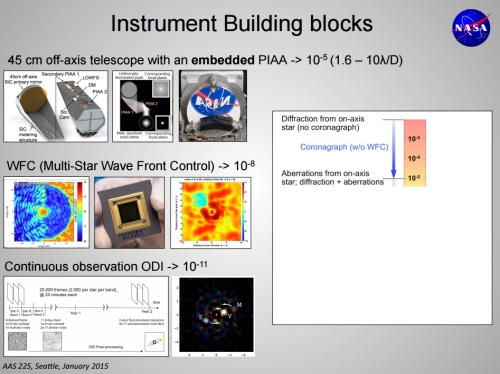
Image: From a presentation on ACEsat by Eduardo Bendek at AAS 2015 in Seattle, available online.
The other key feature of the PIAA is its “inner working angle” (IWA). This is the degree to which the parent starlight is compressed inwards as much as possible, concentrated by the PIAA, in order to create a dark disk around the star that will allow any exoplanets to stand out. The PIAA is the only coronagraph considered for WFIRST that has an IWA that would allow a planet in the habitable zone of a Sun-like star to be seen. The smaller the IWA the better. This also allows for smaller orbits, which of course require less time and images to determine, thus allowing ODI to come into play. The price for this precision is that the coronagraph is extremely sensitive to “jitter”, small unwanted movements caused by the steering reaction wheels, and thermal instabilities.
The WFIRST simulation data demonstrate how severe this can be and disruptive to successful exoplanet characterisation. It was because of thermal instabilities that silicon carbide was chosen as a construction material, as it is very stable to changes in temperature, defined by the “coefficient of thermal expansion”. Jitter is actively mitigated by the use of a “fast” tip/tilt mirror incorporated into the optical train that the coronagraph sits in, one that uses starlight rejected by the coronagraph to feed a computer that in turn controls the position of the mirror to correct any wavefront errors. Such is the importance of this part of the telescope that despite the presence of an on-board computer, “real time” modifications will still need to be made from the ground, all of which adds to the “operations costs” described later.
Wavefront errors arising from other sources are corrected in turn by an electromechanical, MEMS-deformable mirror (DM), also in the optical train and also feeding a guiding computer. The equivalent of active optics in a ground-based telescope. Imperfections in the telescope mirror can allow stray starlight in the firm of “speckles ” that can be removed this way.
Working with a Close Binary
With ACEsat, which is in the unusual situation of imaging a close binary system where light from one star will seep into planetary imaging of its neighbour, deformable mirrors managed by a “multi-star wavefront control” computer algorithm counteract this and in doing so open the door to imaging planets around the many binary systems close to the Solar System. All of these will reduce the telescope’s overall throughput, which demonstrates why it is so important not to throw away light in the coronagraph given there is so little to start with. Other conventional glass mirrors also possess such properties, but for a small telescope are prohibitively expensive and heavy. The initial ACEsat bid had the telescope in an “Earth trailing orbit”, drifting away at 0.2 AU per year but in a thermally stable, easy (cheap) orbit in direct contact with Earth. Traditionally such missions utilise the superior but more difficult to reach Earth/Sun Lagrange 2 point. Trade offs are a necessity when funds are low.
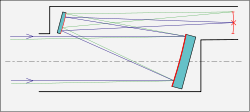
The other issue is the amount of light the coronagraph allows through to the all important spectrograph. ACEsat is an off-axis telescope in that its mirror is offset to focus its light to a point outside the telescope, so that there is no obstructive secondary mirror or coronagraph to waste precious incident light (up to 20% is obstructed in on-axis telescopes). The coronagraph thus runs down the side of the telescope and is actually embedded into it, which is possible with a smaller telescope with a less complicated mirror arrangement in its coronagraph, and embedding helps significantly reduce the damaging “jitter” described above.
Image: A simple illustration that illustrates the off-axis concept. Here the red line is the focal plane where spectrograph, imaging camera, polarimeter etc are located. Credit: Wikimedia Commons / Ashley Baldwin.
Inside the PIAA Coronagraph
The PIAA is the only coronagraph with near 100% throughput, thus allowing all light delivered by the telescope for characterisation in the spectrograph at the end of the “optical” train. The importance of this is that spectrographs unavoidably have considerably less than 100% throughput while some coronagraphs have only 20% throughput! A PIAA coronagraph in essence uses two sets of “aspheric” (curved at edges) mirrors to concentrate the Point Spread Function (PSF), or disk of light produced by a telescope when it images a point light source like a star. It removes the sharp diffraction rings that surround the central disk to create a dark area where reflected planetary light can be seen. In essence, the central starlight is slowed down whilst the extreme edge is allowed as normal, leaving a dark area around the edges.
A simple “stop” blocks off the Gaussian-like “peak” of starlight, creating a dark starlight-free zone around the PSF in which, with suitable contrast and light, an exoplanet image can be seen. The PIAA is unique amongst coronagraphs in allowing through most of the planet light, which is vital when one thinks just how faint this is. Up to ten billion times less than the star in the visible spectrum, though less as wavelengths increase into the infrared, which allows for lower imaging contrast but at the price of image resolution, which is derived from wavelength/telescope aperture.
ACEsat takes advantage of the PIAA design to actually embed it around the telescope secondary and tertiary mirrors, which feed the concentrated PSF starlight to an occulter at the first focal plane, where most of it is blocked and some is redirected to a computer that controls the deformable mirror “upstream” that then corrects any wavefront errors. This process helps create the dark area surrounding the central PSF described above, allowing planet light to pass unhindered through the optical train to the final focal point, and imaging via electron magnifying CCD (EMCCD) cooled to minus 85° C. This cooling prevents “dark current”, electrical current arising spontaneously within the pixels of the sensor array and causing them to activate in the absence of genuine photon stimulation.
The EMCCD sensor is now standard for visible imaging, with its individual pixels (1024×1024) releasing additional electrons when stimulated by a light photon in order to boost the final image/signal. The embedding of the PIAA around the telescope mirrors IWA unique design features that are only practical in smaller telescopes but do increase the telescope stability many fold. It is impossible to overstate just how important telescope stability is when imaging faint light sources light years away. Despite a “vibration source isolation system” that separates the telescope from its bus and its 23 fine-pointing reaction wheels, the transfer of some vibration or “jitter” is unavoidable, as is some degree of thermal instability, and this needs to be controlled to within 0.5 milli-arc seconds by tip/tilt mirror and related computer for a successful image to be formed.
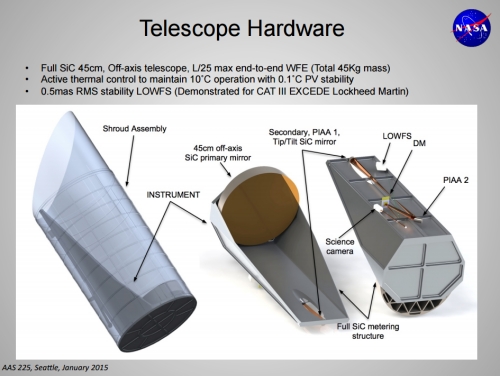
Image: ACEsat hardware, from Eduardo Bendek’s presentation at AAS 2015.
The PIAA’s small IWA, though helpful in allowing planets to be imaged as near to the stars as possible, also increases the telescope’s sensitivity to jitter. The larger and more sensitive the scope, the greater this sensitivity. ACEsat is ahead of its time because of its small size, allowing greater stability. This approach is so far only possible up to 1.5m and the main drawback is that, although the planets can be characterised in terms of mass and orbit, detailed spectroscopic analysis, looking for atmospheric constituents for instance, is not possible. The larger versions simply allowing a wider radius of imaging. Even the 45 cm version of ACEsat was intended for an extended mission to image Sirius, Procyon and Altair, with the latter as far out as 16 light years. All of these are either genuine or visual binaries with a bright member, so fitting in well with ACEsat’s imaging strategy.
ACEsat clearly illustrates the incredible precision that would be needed on the kind of multi-metre aperture telescopes that would have the light gathering sensitivity to spectroscopically analyse exoplanets. What it does do, though, is introduce the new and potent orbital differentiating post-processing technique that could work just as well or indeed better with larger telescopes, whilst taking some of the contrast role off of the coronagraph. The need for prolonged imaging to obtain as much of an exoplanetary orbit as possible is evident, which requires dedication. ACEsat proposed observation periods run of up to 100 days at a time.
A Future for ACEsat?
There is clear synergy between ACEsat and WFIRST in that the ongoing research on the latter will improve the PIAA coronagraph further. The complex internal architecture of the National Reconnaissance Office (NRO) array that forms WFIRST is such that it effectively makes the telescope segmented, thus providing a comparison of a monolithic telescope versus the segmented design. If the hybrid Lyot remains the coronagraph of choice for WFIRST, should a revised version of ACEsat become reality then there will be opportunity to compare coronagraphs in the field and not just in the lab. The ACEsat design itself is a smaller version of the Exo-C Probe concept telescope that arose from NASA’s desire to look at exoplanet alternatives to WFIRST. As it is likely that any large space telescope of the future will be equipped with high performance coronagraphs, both WFIRST and ACEsat present perfect test beds.
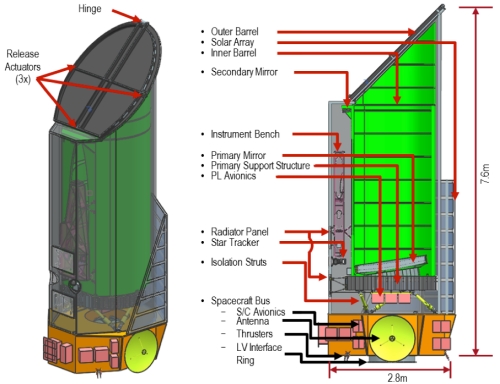
Image: The monolithic 1.5m off axis Exo-C telescope that is near identical to the biggest version of ACEsat. The only difference is it uses a Hybrid Lyot coronagraph instead of a PIAA and it isn’t embedded in the telescope wall. Otherwise, this is a good representation of a big ACEsat or indeed any unobstructed coronagraph exoplanet imager. Image credit: Exo-C Concept Development page / JPL.
ACEsat was unsuccessful for its SMEX bid. Its design is robust and its construction material, silicon carbide composite, which is used for the entire satellite, has an extensive and successful heritage in Europe. The mission objective was purely Alpha Centauri, so if nothing was discovered for any reason, then the funding is wasted as the telescope at just 45cm was bespoke for our nearest stellar neighbour. It will interesting to see what modifications any funding resubmission has. For one, it is likely to be larger to allow characterisation of more than one star system and not have “all its eggs in one basket”. The design can be extrapolated to at least a 1.5m aperture with eighty times the light gathering of the original ACEsat and more than three times the resolution. This should allow a planets as far out as thirty light years to be imaged over the extended period only a dedicated telescope can provide.
The question is just how much bigger the available funding would allow this telescope to become. The now familiar Dawn mission was cancelled/postponed on several occasions amidst a NASA funding crisis but subsequently reinstated when it’s manufacturers, Orbital Sciences Corporation, agreed to build it at “cost”, so confident were they in the ability of its innovative design to deliver. A decision that more than paid off with great science and publicity.

Image: Potential targets for an expanded ACEsat. Credit: ESO.
It’s worth mentioning that an 80m ground based ELT, based in optical viewing conditions on the Antarctic domes, could be expected to characterise 40 of the nearest Earth-like planets. An enhanced ACEsat of, say, 1.5m stands respectable comparison to this and illustrates the huge advantage of imaging above the atmosphere. And at a fraction of the cost.
The only question that leaves unanswered is, “how big”? The largest funding pool available for such missions is the Explorers programme of TESS fame. It is about $200 million with facility to top up with any savings made on using a smaller than expected launcher – a distinct possibility for a small telescope made from ultra light material. Silicon carbide is 5-10 times less heavy than conventional materials and equivalently cheaper. Capping mission time to, say, just two years is a gamble that releases funds from mission operations and systems engineering (running costs !) into the telescope proper, on the assumption that even in this shorter time enough high quality science will be delivered to justify a significant extension. Consumables (fuel etc) reflect this by being far more than is necessary for the primary mission. If sensitive spectrographs like ESPRESSO come on line in the next two years, their precision work will provide a list of nearby targets to reduce exoplanet search times within previous mission time. The TESS spacecraft bus has a life expectancy of up to seven years or more despite a two year primary mission.
There will be no additional funds for exoplanet imaging next decade. If “ACEsat plus” is approved, that will be two exoplanet imaging missions to supplement PLATO and the ELTs, preparing hopefully for the big telescopes of the next decade. It may not be the USS Enterprise, but an enlarged ACEsat telescope would enable man to boldly go where no man has been before. Unlike a manned spacecraft, its ingenious design and novel construction material, silicon carbide, will cost a small fraction of conventional telescopes and fit within pre-existing funding envelopes. Its coronagraph, sophisticated wavefront control and processing algorithms will allow imaging of our nearest stellar neighbours and open up a whole new investigation area in binary systems.
By far and away the most exciting goal is looking for planets in the habitable zone of the two sun analogues of the Alpha Centauri system. In doing so it will be years ahead of its time, dovetail with the small exoplanet technology demonstrator element of WFIRST and be the forerunner of the large telescopes to come. A tremendous achievement if Ames and Northrop Grumman can pull it off. Dawn of a new age?
We live in interesting times. Parlous financial circumstances have not stopped the eighteen month placement of a lunar UV telescope by a Chinese team, while India is launching an X-ray telescope. Things are moving forward fast. The question is, just how far are this US team prepared to go to achieve their visionary goal and maintain an obvious technological lead? Success could lead to the first habitable exoplanet or at least a terrestrial planet in a habitable zone, so the rewards are potentially huge, while the costs are low.
——-
Further Reading
“From Cosmic birth to living Earths: A visionary space telescope for UV-Optical-Near IR Astronomy”: AURA, 2015. http://www.hdstvision.org/report/
“How to directly image a habitable planet around Alpha Centauri with a 30-45cm telescope”: AAS Belikov et al., 2015. http://arxiv.org/abs/1510.02479
“Space mission and instrument design to image the habitable zone of Alpha Centauri”: Bendek et al 2015. http://adsabs.harvard.edu/abs/2015AAS…22531102B
“The orbital design of Alpha Centauri Exoplanet Satellite (ACEsat) Heliocentric orbit design: Interplanetary small satellite conference, Beyond LEO”: Weston et al 2015. http://digitalcommons.usu.edu/cgi/viewcontent.cgi?article=3228&context=smallsat
WFIRST-AFTA, STDT final report: Spergel et al 2013. http://wfirst.gsfc.nasa.gov/science/sdt_public/WFIRST-AFTA_SDT_Final_Report_Rev1_130523.pdf
“The search for habitable worlds 1: The viability of a star shade mission”: Turnbull et al, 2012. http://arxiv.org/abs/1204.6063
“Design study of an 8m monolithic mirror UV/Optical space telescope”: H Philip Stahl 2009. http://www.stsci.edu/institute/atlast/documents/stahl_8mDesign_SPIE2008.pdf
“WFIRST-AFTA Coronagraph instrument low order wavefront sensing and control”: Shi et al, JPL Cal Tech, 2014. http://home.strw.leidenuniv.nl/~kenworthy/_media/nospeckles:shi-afta-c_lowfsc.pdf
“The phase induced amplitude Apodization coronagraph”: Guyon et al, 2006. http://exep.jpl.nasa.gov/TPF/Coronagraph_PDFs/CWP2006_31_Guyon_pp157-161.pdf
“High contrast imaging and wavefront control with a PIAA coronagraph: Laboratory system validation”: Guyon et al 2009. http://arxiv.org/abs/0911.1307
“Low order wavefront sensing and control and Point Spread Function calibration for direct imaging of exoplanets”: JPL presentation : Guyon and Traub 2014. http://exep.jpl.nasa.gov/exopag/exopag10/presentations/Guyon_ExoPAG10_LOWFS.pdf



Various planet survey of Alpha Centauri to date have only excluded the possible existence of Saturn to Jupiter-sized planets so far.
http://www.drewexmachina.com/2014/09/25/the-search-for-planets-around-alpha-centauri-ii/
And now the ongoing issues with Alpha Centuari Bb (which may not exist after all) is beginning to suggest that we may be approaching the limits of what can be done with precision RV measurements. A direct imaging mission like ACESat (or even more ambitious!) is probably going to be the only way to settle the question of any Earth-size or larger planets orbiting in or near the habitable zones of Alpha Centauri A or B.
Here is a 3D animation of the nearest 32 Stars,
http://kisd.de/~krystian/starmap/
And I hope they find at least one planet there but I am thinking that the early planet forming discs may have been dissipated through co-rotation effects. I suspect there is a good chance that the stars share the same rotation direction.
Is this going on your list of space projects?
Tom, yes, added this morning.
Michael,
Your 3D animation is wonderful!
Thanks Joe
It was created by Krystian, it comes in handy if we ever wanted to target more than one Star system with a ‘bus’ spacecraft. It also allows us to use the momentum exchange that is needed in the opposite direction to get another space craft going in the right direction, if we use beamed technologies.
Here is one for nearest 100 000 stars! zoom in and have a look around even to the solar system.
http://stars.chromeexperiments.com/
Something I have been wondering about is what an exo solar system would look like if it has an advanced civilization? Would they clean out any hazards, such as asteroids, comets or even the zodiacal dust, plus these could be used in there development. We would be looking at something 10,000’s to millions of years ahead of us, so would the infrared light be negligible compare to a virgin solar system like ours? What else could be a sign that would not be obvious? How could ACEsat be used to look for this? This scope is a great design, but it may take the findings from TESS and CHEOPS to get it in the budget.
Thank you Michael, the 3D model of the nearby stars (your second link) with possibility to zoom in and out from the sun to the galactic disk is wonderful!
One of the things that has really come home to me while writing this article is the absolute precision required to reach even the apparently low level we have got too. The distances involved , even to Alpha Centauri are absolutely incredible and to get to the point of actually imaging planets around even the nearest and brightest stars is nothing short of miraculous.
Low order aberrations are in essence the biggest contributer to image problems and occur outside of the telescope. Atmospheric distortions for ground based telescopes , pointing or “fine guidance ” errors for a space telescope . The reaction wheels used to steer and point the telescope ( of Kepler infamy ) , thermal variations in the construction material ( hence silicon carbide ,which has low response to temperature at temperatures above -260C ) even can all cause this such is the sensitivity to any movement when using coronagraphs in particular .
“High order aberrations” occur inside the telescope , stray star light, spherical aberration , astigmatism , coma and trefoil etc – all familiar to opticians cause “speckles” in telescope imaging which can be partially mitigated by post processing the raw image but are best avoided in the first place ! These aberrations are best dealt with by the tip/tilt mirror responding to imperfections detected by a wavefront sensor and the high order by deformable mirrors of varying sizes ,the sooner the better. Processing power is key here . The power requirement for some of the E-ELT instruments doesn’t even exist yet but if Moore’s Law holds true it will be available when required .
When reviewing the progress of telescope development on the ground or in space , two of the big areas are adaptive optics and deformable mirrors . That is where R&D is focusing even now and progress is essential to the future of direct exoplanet imaging . One of the principal reasons why the ESA abandoned its “OWL” ( 100m Overwhelmingly Large telescope ) was because of the difficulty of creating the 8m plus deformable mirrors it required to achieve low and high order corrections. It’s easy to forget that as a telescope mirror gets larger all its constituent parts and instruments do too. The Near infrared spectroscope on E-ELT alone is as large as a house ! It’s like a scene from the Giants home in Jack and the beanstalk .
At the other end the microelectromechical ,” mems” small deformable mirrors present equal difficulty in the first generation of direct imaging space scopes like ACEsat and WFIRST. For all telescopes a big issue is also detector devices , particularly in the all important near to mid infrared with the cost and quality of large arrays prohibitively expensive till recently . CCDs are cheap, good and readily available but their use is largely limited to the visible.
Sadly it’s all these things that led to ACEsat being an unsuccessful bid. Exciting science apart the astrophysics budgets are so precips nowadays that a mission has to be a near nailed on success with ready proven technology to atleast TRL 7 to have any chance of approval .
Following on from Andrew LePage , I largely agree that until the 2030s and the arrival of the EPICS imaging device on the E-ELT and large imaging space telescopes, the best bet for confirming exoplanets around even Alpha Centauri and other nearby stars ( Sirius ,Altair ,Procyon etc were targets for the original ACEsat extended mission ) is a beefed up version of ACESat ( that should be able to image out to 10 parsecs ) . In combination with a dedicated astrometry exoplanet telescope such as the 1.2 m TMA telescope the Chinese have planned for early next decade , STEP/SAIL (which is essentially the ESA Theia concept) . The Gaia results ( especially from an extended mission) combined with preexisting astrometry and/or WFIRST data ( if it’s NIR sensor array is good enough) might achieve similar things . The combination of accurate Doppler spectroscopy ,astrometry and the rudimentary direct imaging of ACEsat ( it isn’t large enough to do characterisation spectroscopy ) together should provide a lot of information , with any truly exciting findings helping make a case for mission funding.
Fantastic article, Mr. Baldwin, and thanks for posting it Paul.
Have you ever sat back and just thought about all that information flowing to Earth, constantly, from all over the universe. It’s there, right now, the information that could be a sign of intelligent life, just waiting for the right technology to pluck it from the noise.
Question. What kind of contrast ratio, and hence observation data, could be obtained using the techniques described above, in combination, along with a significantly larger telescope and perhaps other technologies, such as a star shade?
Fascinating article, it will take me a while to digest it fully!
Michael-beautiful simulation by Krystian, I enjoy it very much.
Jim Strom-your comment about all the information coming to us at this very moment is something I didn’t realize until you wrote it, an amazing realization of what universe we live in, and what it offers.
For UK commentators-a couple of us from UK are still organizing meetings of fellow Centauri Dreams fans from time to time, and if somebody is interested in late January meeting, he can contact me through Paul(if this is ok with you Paul) who has my email.
The date is not set yet, but we usually meet in London at the last Saturday of the month for some beer, pizza and interstellar talk.
Yes, by all means, those wanting to connect for the January meet-up can drop me a note and I’ll forward the needed information. Beer, pizza and interstellar talk — a combination that’s hard to beat! Hope to join one of these sessions next time I’m in London.
http://arxiv.org/abs/1512.02652
A new submm source within a few arcseconds of ? Centauri: ALMA discovers the most distant object of the solar system
R. Liseau, W. Vlemmings, E. O’Gorman, E. Bertone, M. Chavez, V. De la Luz
(Submitted on 8 Dec 2015)
The understanding of the formation of stellar and planetary systems requires the understanding of the structure and dynamics of their outmost regions, where large bodies are not expected to form. Serendipitous searches for Sedna-like objects allows the observation of regions that are normally not surveyed.
The Atacama Large Millimeter/submillimeter Array (ALMA) is particularly sensitive to point sources and it presents currently the only means to detect Sedna-like objects far beyond their perihelia. ALMA observations 10 months apart revealed a new blackbody point source that is apparently comoving with ? Cen B.
We exclude that source to be a sub-/stellar member of the ? Centauri system, but argue that it is either an extreme TNO, a Super-Earth or a very cool brown dwarf in the outer realm of the solar system.
Comments: 4 pages, 5 figures, submitted to Astronomy & Astrophysics; Comments very welcome!
Subjects: Solar and Stellar Astrophysics (astro-ph.SR)
Cite as: arXiv:1512.02652 [astro-ph.SR]
(or arXiv:1512.02652v1 [astro-ph.SR] for this version)
Submission history
From: Wouter Vlemmings [view email]
[v1] Tue, 8 Dec 2015 21:00:23 GMT (1652kb,D)
http://arxiv.org/pdf/1512.02652v1.pdf